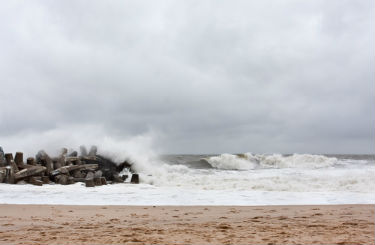$36 Million Project To Build Mantoloking, Brick NJ, Sea Wall

With the federal government recently signing off on a $36 million project to build a steel sea wall for Mantoloking and Brick, it looks like two of the hardest hit areas will be safer from the destruction caused by Hurricane Sandy in on Oct. 29, 2012.
The wall will protect the borough of Mantoloking and a section of Brick's oceanfront beach from future storms and should help restore confidence that another major hurricane won't do the same amount of damage Sandy did. Hopes are high because Sandy unearthed a long-buried sea wall in Bay Head, which is immediately north of Mantoloking. The stone wall was 1,260 meters long and buried beneath the sand. It dates back to 1882. Bay Head survived relatively unscathed, but Mantoloking, which didn't have a sea wall, bore the brunt and suffered serious damage. The Bay Head seawall dampened the waves and there was some flooding, however in Mantoloking homes were reduced to rubble. Experts say the damage in Bay Head was minimized by the sea wall. In advance of the steel sea wall construction, which was slated to begin this month, Homeowners on East Avenue in Mantoloking have started to install a stone wall in front on the ocean homes that will be covered by sand for a natural dune.
The project to protect Mantoloking and Brick will see the installation of four miles of steel sheet piling to be driven deep into the beaches in Mantoloking and Brick in what state DEP Commissioner Bob Martin has said will safeguard Route 35 and nearby homes and businesses from future catastrophic storms. The sea wall will provide the base of a make shift dune system. The steel will extend 16 feet above the beach and get driven down 32 feet below sand level. None of the metal will be seen because it'll be covered in sand.
In addition, the US Army Corps of Engineers is planning beach replenishment project and a dune system, which will help protect nine coastal towns from Point Pleasant Beach to the Barnegat Inlet. In addition, many homes along the ocean have been raised to protect them from future floods.
Some municipalities constructed timber bulkheads, large rock walls and/or concrete seawalls. To stabilize their dunes, some placed geotubes (tubes filled with sand and water wrapped in geotextile fabric) and gabions (wire baskets filled with large rocks) underneath the dunes. Geotubes have been used on the north end of Ocean City and along Cape May’s beaches. Gabions were used in the West Atlantic City portion of Little Egg Harbor. Officials in these and other shore communities credited those measures with protecting homes and residents from Sandy. Meanwhile, in Belmar, a new boardwalk has been built and the town is designing a new $6 million dune system to protect the boardwalk.
Posted by Shawn Clayton on
Leave A Comment